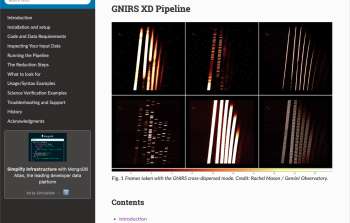sci23052 — Announcement
US NGO Completes the Science Verification of the GNIRS XD Pipeline
October 6, 2023
GNIRS is Gemini North’s second most subscribed instrument and covers a wide spectral range from 0.8-5.4 micrometers. Since 2010, it has accounted for about 20% of Gemini North’s total yearly science exposure time. GNIRS' most popular configuration, 32 mm XD (cross-disperser mode), has an unofficial semi-automatic data reduction pipeline (XDGNIRS, built on Gemini IRAF tasks) that has not been verified to produce science-grade products. This is in addition to current software (Gemini IRAF, IDL, and Python) that can already reduce GNIRS data.
The US National Gemini Office (US NGO) staff has now performed a science verification and modernization project on the pipeline. The project involved testing the pipeline on various astronomical sources, updating the code’s syntax to be compatible with Python 3.7.11, and ensuring that the code complies with the software installed in the latest version of the Gemini Virtual Machine.
The science verification began with reducing data for the brown dwarf WISE0410 and the galaxy NGC 3031. After successfully running their data through the pipeline, we partnered with the Brazilian NGO head, Alberto Ardila, who has abundant experience using the GNIRS instrument. Alberto compiled a list of eight galaxies with published spectra and varying weather conditions, as denoted on the Gemini Observation Archive. We successfully ran all eight examples through the new version of XDGNIRS and found that all the emission/absorption lines identified in the published spectra were also present in our spectra. The pipeline handled data marked as ‘bad quality’ without issues and their reduced spectra closely resembled the published versions.
In addition to updating the pipeline’s code, we created two resources for the users: a GitLab repository and a READtheDocs version of the pipeline’s user manual. The GitLab repository contains the pipeline’s code and the fifteen datasets we used to test the pipeline with reduced products so the user can compare their work to ours. The READtheDocs contains all the information included in the original manual and instructions for the new features we added in this version, including an updated ability to query SIMBAD for a source’s redshift. The documentation also includes a section that displays all the acceptable inputs that either allow the user to manually perform specific tasks or perform additional tasks that the pipeline does not perform by default, such as the ‘shift_to_rest’ command, which obtains the source’s redshift from SIMBAD and shifts the reduced spectrum into the rest frame.
The GNIRS XD pipeline is now available to all Gemini users and can be accessed on this GitLab repository. A more detailed project summary can be found on the US NGO’s website. For more information, please contact Brian Molina Merino, Data Analyst at NSF's NOIRLab.
About the Announcement
| Id: |
ID
sci23052
|
